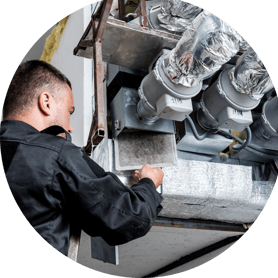
When we think of air pollution, we typically imagine smog-filled cities or large industrial sites. However, Indoor Air Quality (IAQ) can be just as detrimental to our health. On average, Americans spend approximately 90 percent of their time indoors, where air quality is sometimes questionable. The air quality indoors is often worse than outdoors, containing 2 to 5 times higher concentrations of pollutants.
Prolonged exposure to subpar IAQ can have detrimental effects on your health, leading to Sick Building Syndrome (SBS). This condition results in a variety of symptoms, including but not limited to headaches, nausea, and fatigue. In this blog, we’ll explore the adverse effects of SBS and the importance of maintaining healthy IAQ.
Symptoms and Causes of Sick Building Syndrome
SBS refers to a condition in which individuals experience a range of health issues. SBS is directly attributed to poor IAQ, although the exact cause is difficult to pinpoint. Diagnosing SBS can be difficult, as symptoms can vary, and SBS resembles other illnesses like the flu, common cold, and seasonal allergies.
The key indicator of SBS is that your symptoms subside and improve once you leave the building and return once you’re back inside the building. Another indicator is that your coworkers or other occupants are experiencing some of the same symptoms.
Symptoms associated with SBS:
- Difficulty breathing
- Throat irritation
- Runny or itchy nose

- Dry, itchy skin rashes
- Watery or itchy eyes
- Headaches
- Dizziness
- Fatigue
- Body aches
- Dry cough
- Nausea
- Difficulty concentrating
SBS is typically treated by reducing exposure to the source of the illness. However, the only sure way to avoid SBS is to improve IAQ.
Causes
Along with diagnosing, determining the exact culprit of SBS can be challenging. Common pollutants and causes include:
- Building materials
- Volatile Organic Compounds (VOC)

- Chemical cleaning products
- Excess moisture
- Vapors from paints & old carpets
- Fumes emitted from office equipment (printers and fax machines)
- Carbon monoxide
- Poor ventilation
- Mold
Some of these issues can develop and worsen gradually, going completely unnoticed.
Importance of Indoor Air Quality & How to Improve It
It's crucial to understand that the consequences of poor IAQ extend beyond the temporary discomfort of SBS. Infections, respiratory problems, lung cancer, and chronic lung diseases are some of the long-term health implications of prolonged exposure to poor IAQ.
A silver lining of the pandemic was that it shed light on the significance of IAQ and its role in our daily lives. Thankfully, there are effective methods and strategies that you can employ to improve IAQ and protect your health:

- Proper Ventilation. A building’s ventilation level refers to the amount of outdoor air that flows indoors. Opening windows, adding portable filtration options, and directing airflow can improve building ventilation.
- Adequate HVAC Systems. The primary function of Heating, Ventilation, and Air Conditioning (HVAC) systems are to help maintain healthy air quality through circulation and filtration. HVAC systems should be sized appropriately for the number of building occupants and use HEPA filters. Using HEPA filters helps remove dust, pollen, mold, bacteria, and other harmful airborne particles.
- Regular Cleaning. Regular cleaning and sanitation is imperative for improving IAQ. Regular cleaning reduces the chances of mold and hazardous bacteria developing. When cleaning a facility, be sure to use EPA-approved products. Using strong, chemical cleaning products will pollute and contaminate the air.
- Incorporating Plants. Polluted indoor air typically contains VOCs, a large group of chemicals and gases emitted by many products. Certain indoor plant species can help filter and reduce the number of VOCs in the air, improving IAQ.
- Routine Maintenance. Conducting routine maintenance in and around the facility will prolong the life of both your equipment and your building. Using technology like the Internet of Things (IoT) or a Computerized Maintenance Management System (CMMS) can help automate the maintenance process and notify personnel of any necessary repairs. By ensuring that your HVAC, plumbing, and ventilation are functioning properly, you reduce the risk of such equipment failing and contributing to poor IAQ.
A Solution to the Problem
SBS serves as a reminder that our time indoors and the air we breathe can significantly impact our health – especially as climate change intensifies and temperatures continue to rise, forcing us to spend more time indoors.
By understanding the causes of poor IAQ, you can take proactive steps to improve the IAQ of your facility and create a healthier environment for all occupants.
For those companies that do not own their buildings, it's a good idea to communicate with the landlord to prioritize the issue and collaborate on solutions.
With more than 35 years of experience in the facilities maintenance industry, Flagship understands the powerful impact that cleanliness and air quality have on workplace health. We’re committed to protecting all our employees and clients from the dangers of SBS.
We are a single-source solution for all your facilities maintenance needs. For more information about our tailored services, contact an expert today.





Leave a Comment